The WSL served up the first North London derby of this season in the latest round of fixtures, with in-form Arsenal Women hosting Tottenham Hotspur Women, who have yet to win a game this season. This tactical analysis will look at both sides’ tactics in the game, seeing why Arsenal won the game and Tottenham lost. We will see how Tottenham struggled to get going in this game, and why Arsenal stormed to a commanding lead by half-time.
Lineups
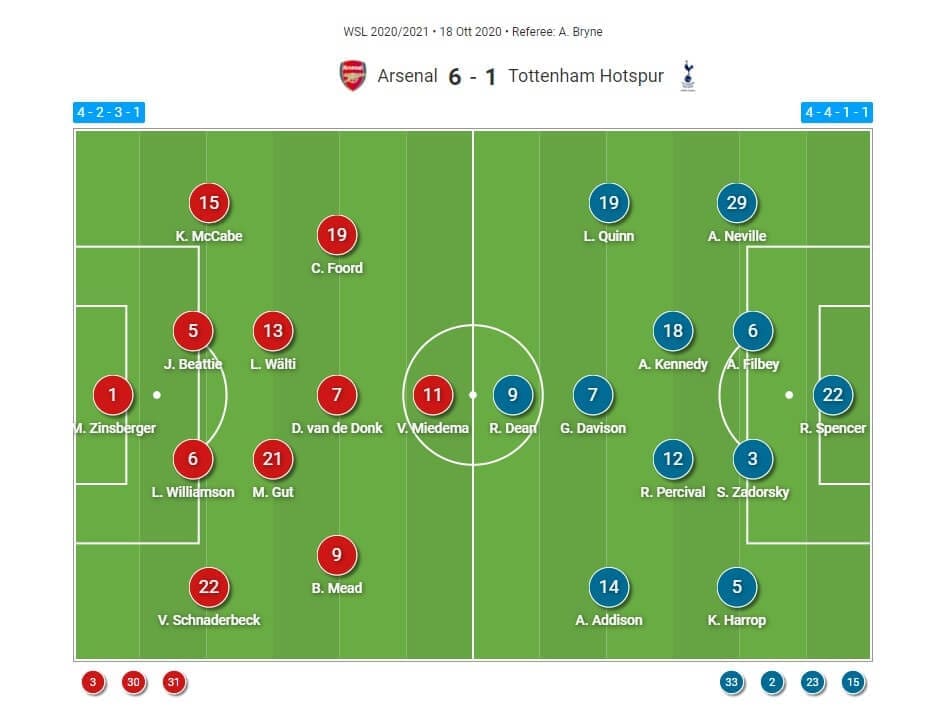
Arsenal Women made just one change to their starting line-up from the 5-0 win against Brighton and Hove Albion Women last time out. Germany right-back Leonie Maier was the latest player to join the injury list at Meadow Park, with Austria captain Viktoria Schnaderbeck coming into the team in her place, having come off the bench against Brighton. Due to the enormous number of injuries, Arsenal were only able to name four substitutes for this game, with teenage midfielder Ruby Mace and defender Anouk Denton both named again on the bench. Star striker Vivianne Miedema was on the hunt for the one goal more she needed to become the WSL’s all-time top goalscorer.
Tottenham Hotspur Women, meanwhile, made four changes from the side that narrowly lost 1-0 to Manchester United Women at home in their last game. Defender Siri Worm, midfielder and captain Josie Green, and striker Rosella Ayane all moved to the bench, whilst centre-back Hannah Godfrey missed out altogether. In came Anna Filbey, Kerys Harrop, former Arsenal midfielder Lucy Quinn and striker Rianna Dean to replace them. USA striker Alex Morgan was again not included in the squad, as she continues to build her fitness up.
Arsenal’s attack
The first thing we will look at in this analysis is Arsenal Women’s attack, seeing why they took such an early lead. Tottenham Hotspur Women did create their own problems at the back, which we will come to, but Arsenal set up in a way that allowed them to play through the Tottenham defence with ease.
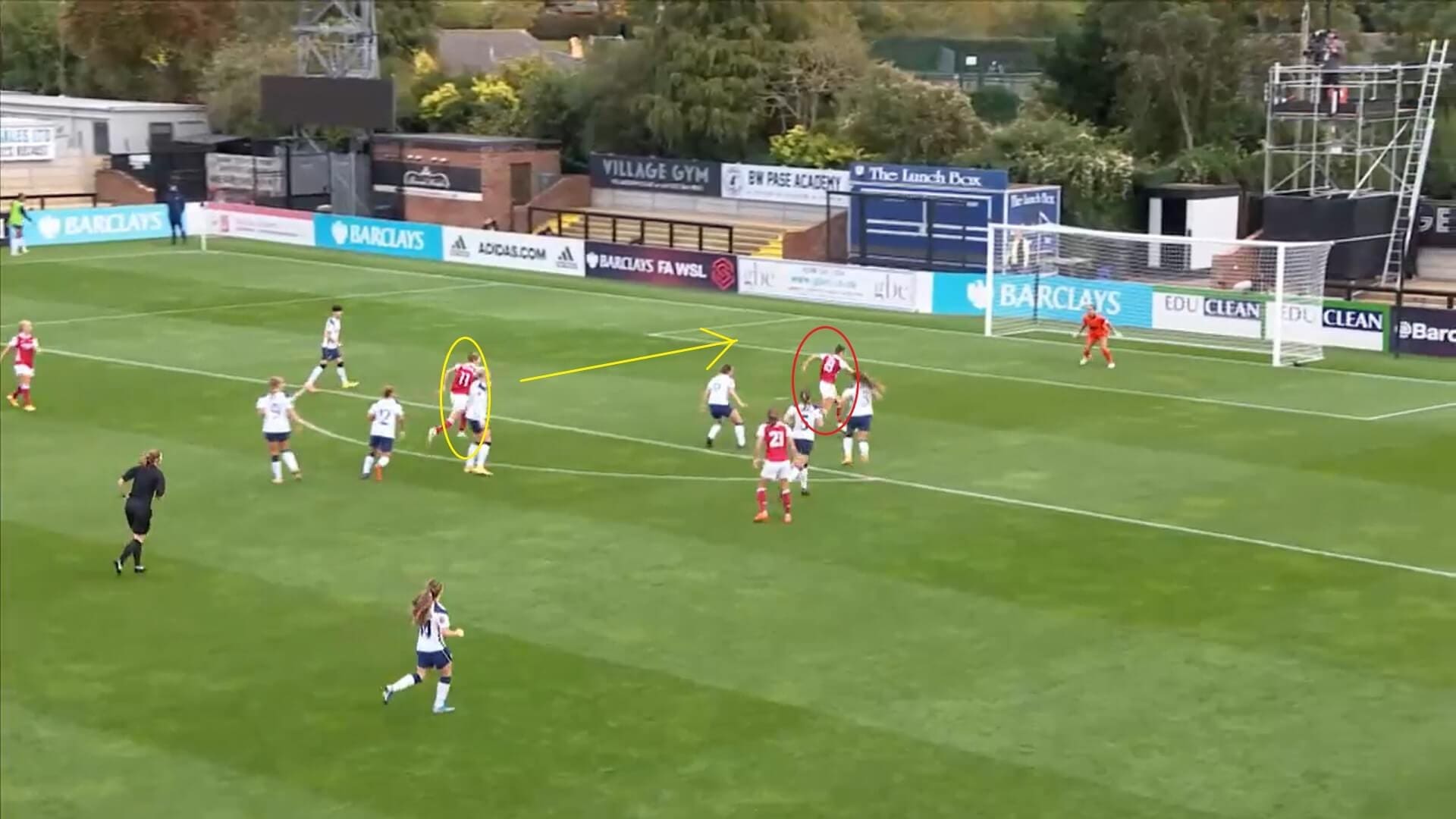
Arsenal have played Australia forward Caitlin Foord and Netherlands striker Vivianne Miedema on the same pitch this season, and this allows them to switch their formation around whenever they need to. We know that Miedema likes to drift over to the wings at times in the game, and Foord has the ability to then move centrally to fill the gap. However, as we can see here, they can also form a front two, ensuring that the ball can get through the defence and then be passed into space to be scored, as happened here.
We can see how Tottenham have focussed on Foord, who is in the red circle with the ball. However, they have not communicated with each other to ensure that they don’t all move towards the ball, and this was the problem throughout with their defence. As a result, the gap is left open for Miedema to make the run through, and she receives the ball and scores here. As well as highlighting Tottenham’s problems, this also shows how Arsenal are clinical in front of goal, which is one of the main reasons they are in such a strong position in the league.
However, the main reason that Arsenal were able to attack this way was because of the role played by Netherlands midfielder Danielle van de Donk.
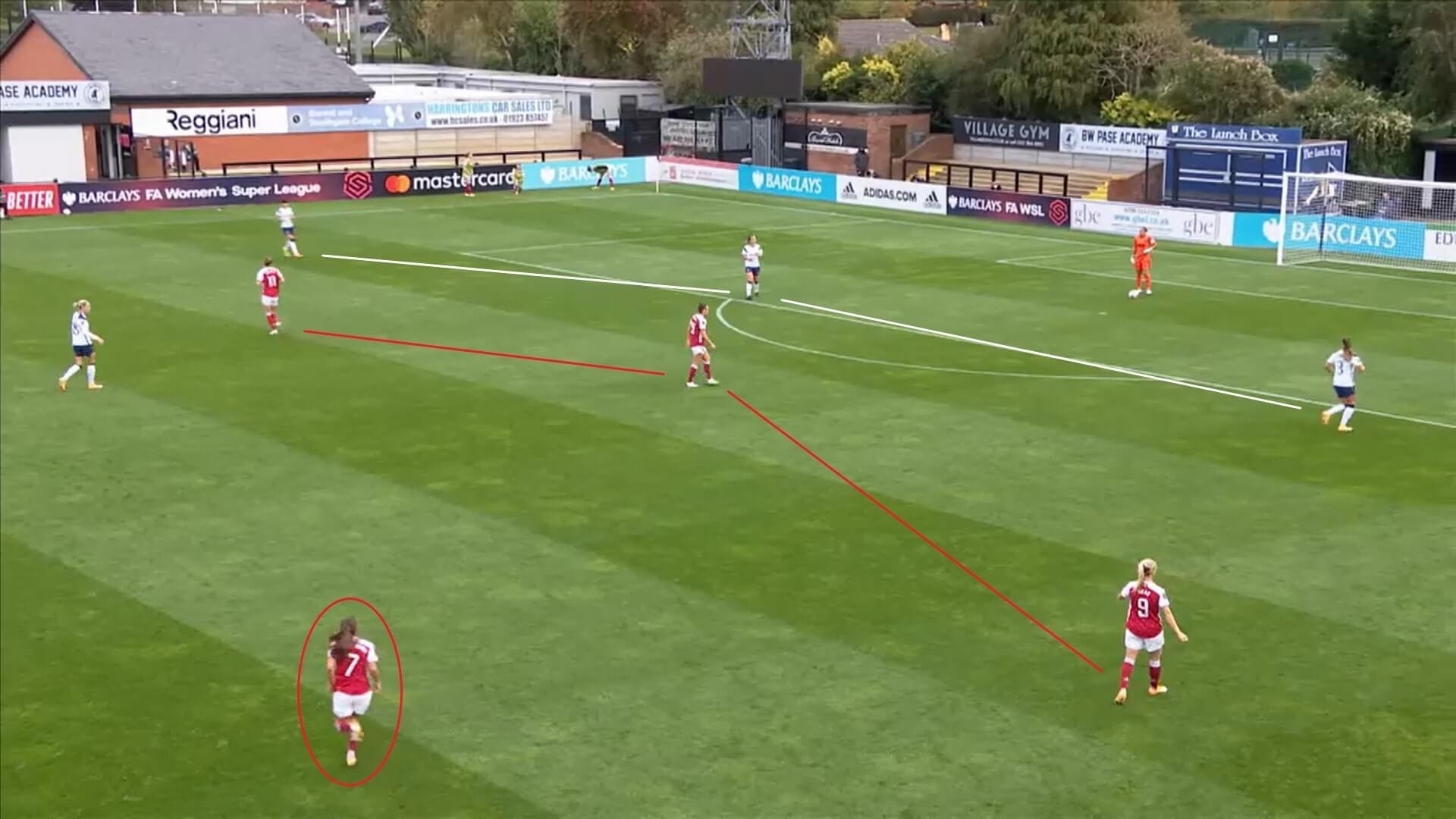
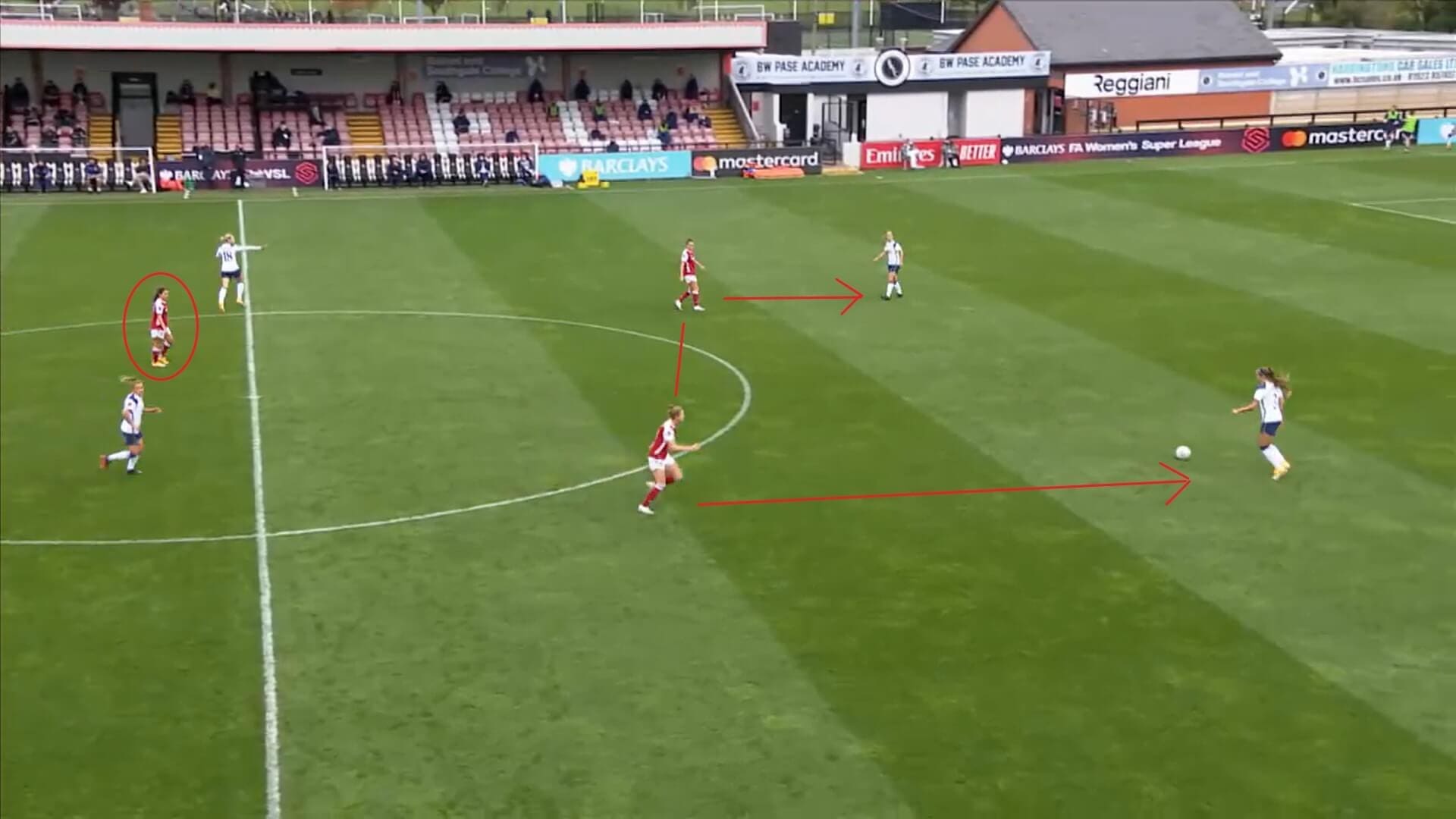
The Dutch international took up a position where she could control the game for Arsenal. This position was just behind the main attacking line, meaning she could offer support wherever it was needed, and also be the link between the midfield and defensive players and the forward line.
The first image shows Tottenham lining up with three at the back, and Arsenal’s forward line of Beth Mead, Vivianne Miedema and Caitlin Foord stretching across the pitch to match their structure. However, whilst this means that Tottenham have little space to get the ball out of their final third, there is plenty of open space behind Arsenal’s attackers. van de Donk therefore positions herself in this area, so that, should Tottenham goalkeeper Becky Spencer look to play there, she can win it and get it back to her teammates in front of her. If the ball is instead played short, she can move to that area, offering a passing option if her teammate wins the ball, and providing the link between all three.
The second image shows a similar situation. Like in the first image, Arsenal have two players matching the two Tottenham defenders, and van de Donk is behind, in the red circle, between the other two Tottenham players. By putting herself here, she stops Tottenham passing the ball out through the middle of the Arsenal attackers, because she would then be able to pick it up and move it forward again. Instead, they now have to make a really accurate high pass, or get it around the side of Arsenal’s players. Both of these are more difficult to do, and so we can see how van de Donk’s positioning helps her team when out of possession.
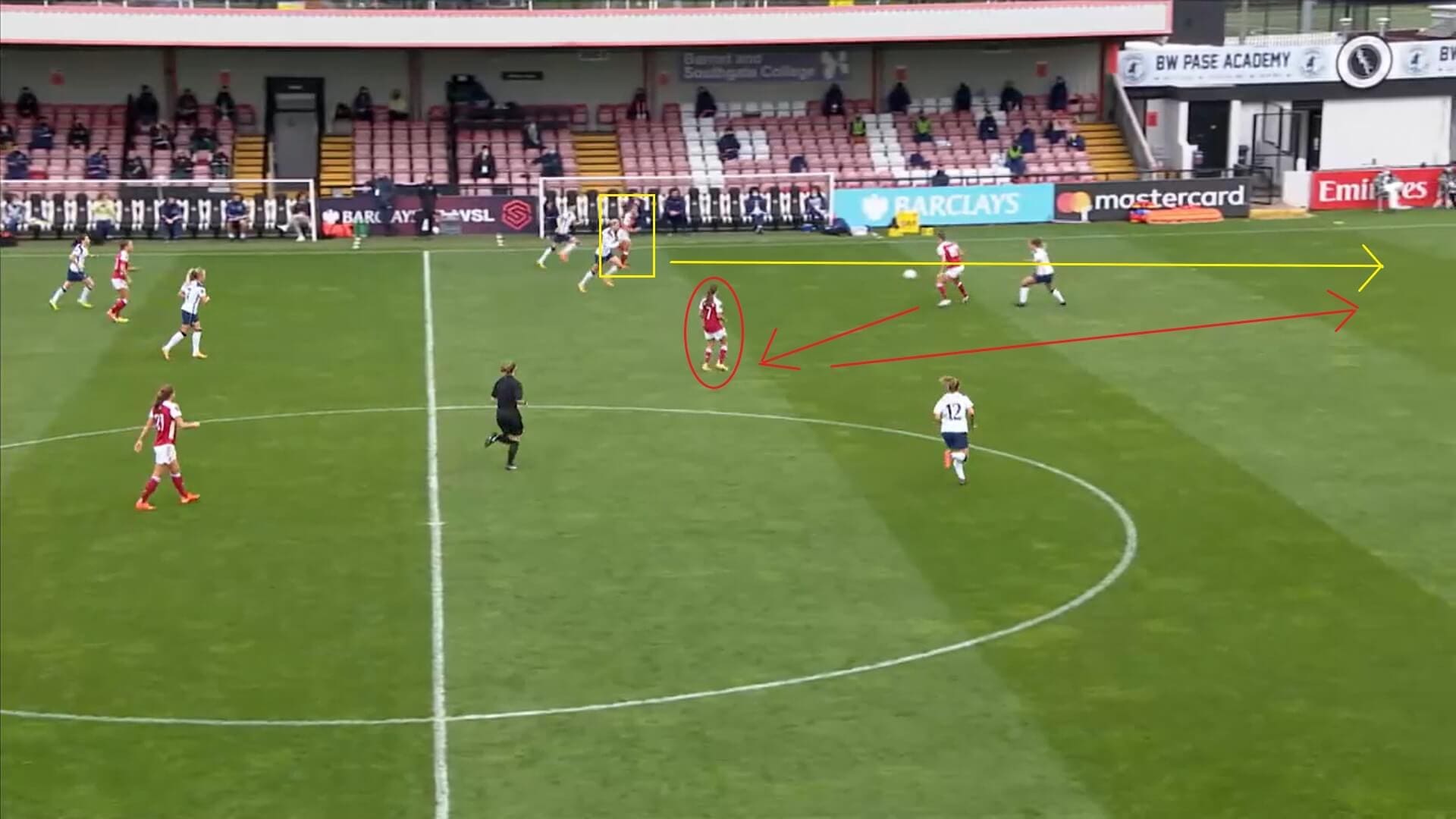
However, she wasn’t just positioning herself correctly out of possession, but also when her team had the ball, setting up opportunities for them. Here, we can see how she receives the ball, and, with her first touch, moves it through the gap in the Tottenham defence, where it is then met by Vivianne Miedema in the space behind. This one-touch passing ability takes time away from the Tottenham defence; had van de Donk looked to control the ball before passing, there is a chance that she might have been closed down. The move is helped by Miedema making the run early, as the yellow arrow shows, giving her national teammate a target to pass to, but this is another example of van de Donk being instrumental in her team’s attacking play.
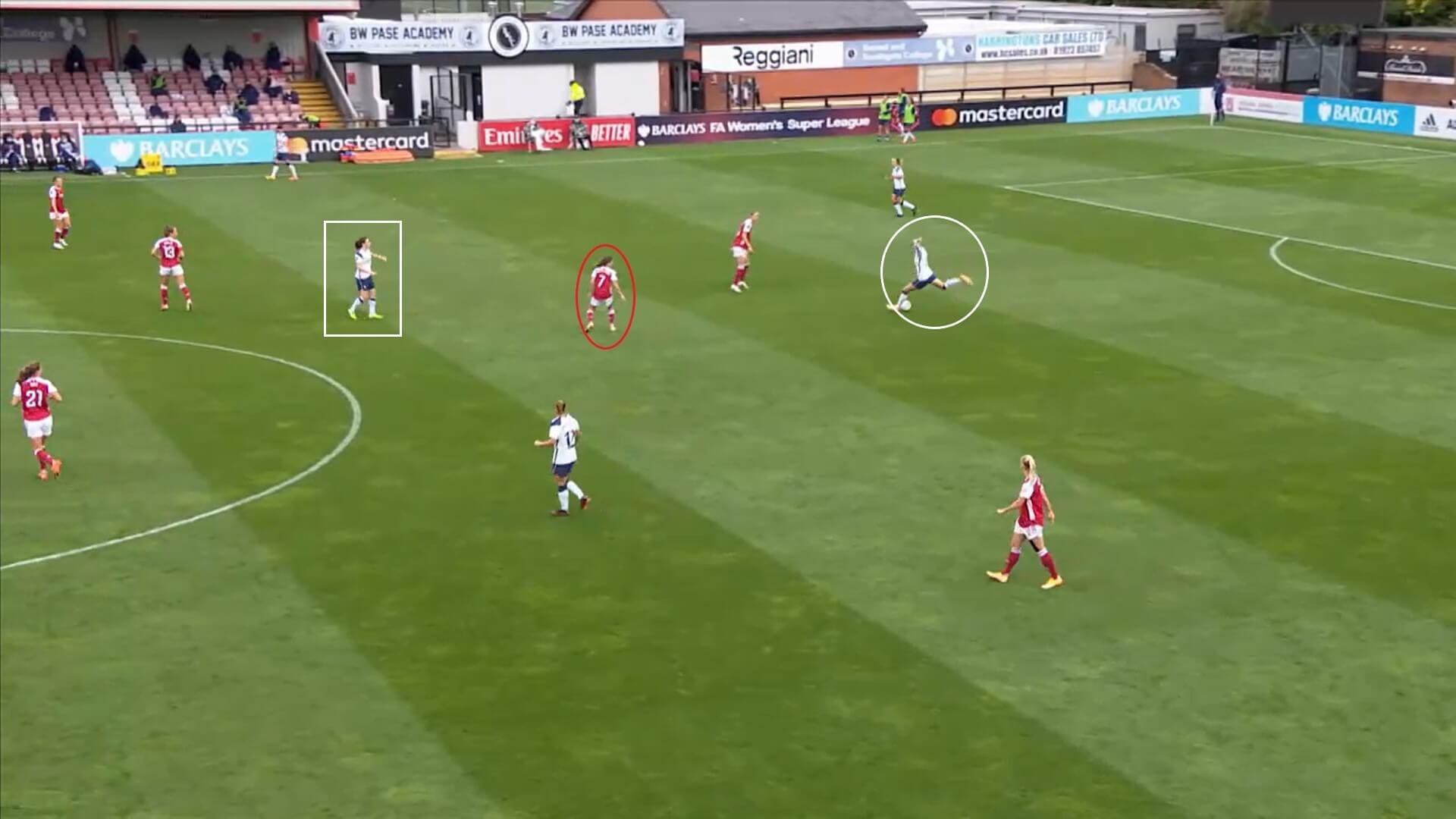
This time, Tottenham midfielder Alana Kennedy has the ball in her third, and is looking to get it out of danger. van de Donk is now one of the furthest players forward for Arsenal, and therefore needs to help defend from the front, as Arsenal’s tactics dictate. She positions herself cleverly here, ensuring that the quick, short pass can’t be made to the player in the white square. Instead, Tottenham have to make a long pass through the air. This is where Arsenal were dominant, constantly winning balls aerially, and so, by forcing Kennedy to make this pass, van de Donk gives her team the opportunity to win the ball where they are dominant.
Tottenham Hotspur’s defence
However, whilst Arsenal Women were by far the better side in the first half, it wasn’t all of their own making. Tottenham Hotspur Women also made plenty of errors both in defence and in attack. In defence, they continually allowed Arsenal to create opportunities and use space behind them with little opposition.
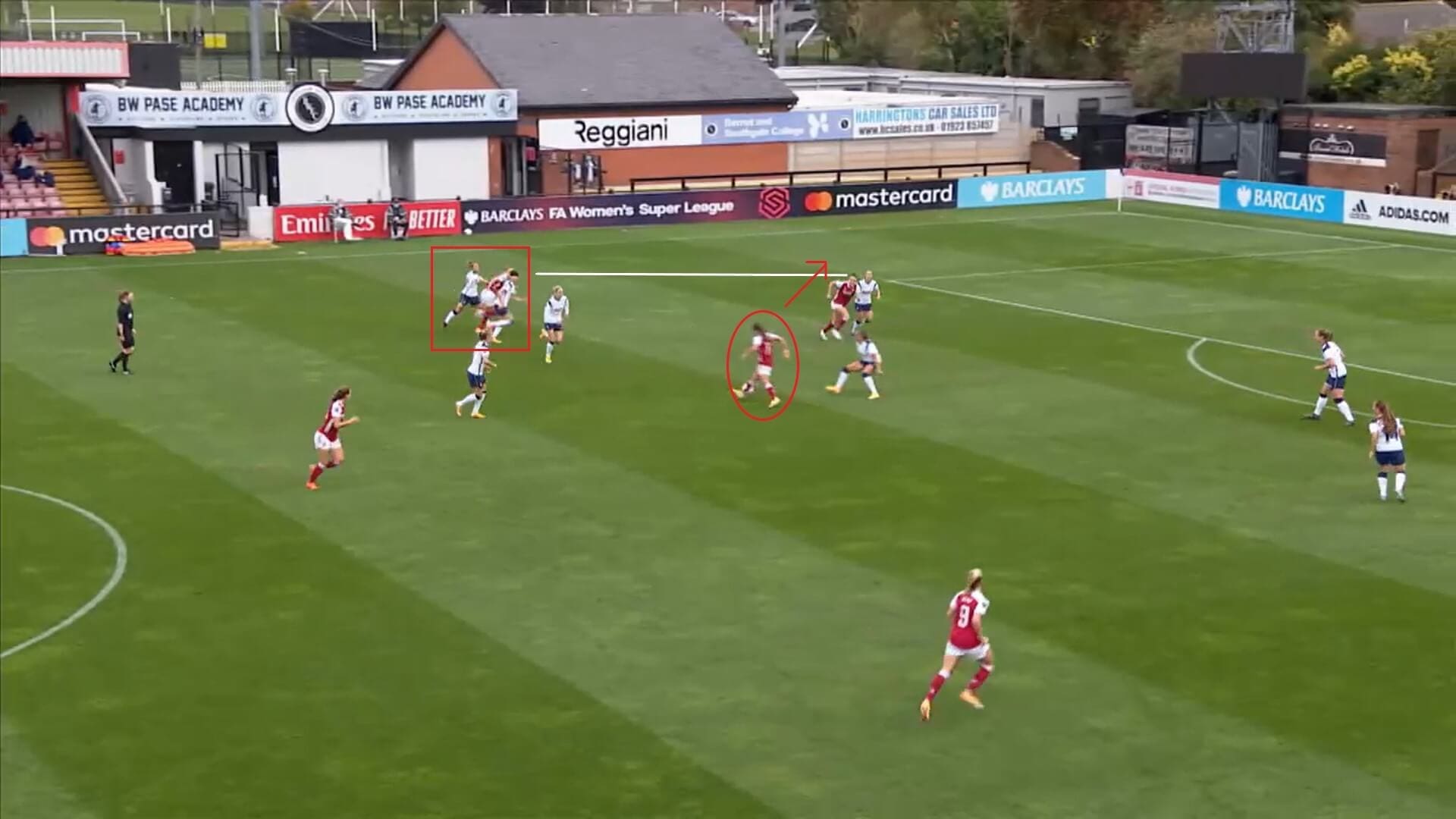
In this image, we can see how Tottenham have left a gap open in their defensive line, as shown by the white line. This was a key feature of their game in the first half. In this particular example, right-back Ashleigh Neville has moved too far up the pitch, allowing Arsenal to get the ball through to Miedema, who is in the red square, who then scores her record-breaking goal, and her first of the game. This all came from Neville’s movement towards Miedema, and we can see how Tottenham made it very easy for Arsenal to open them up and create plenty of opportunities.
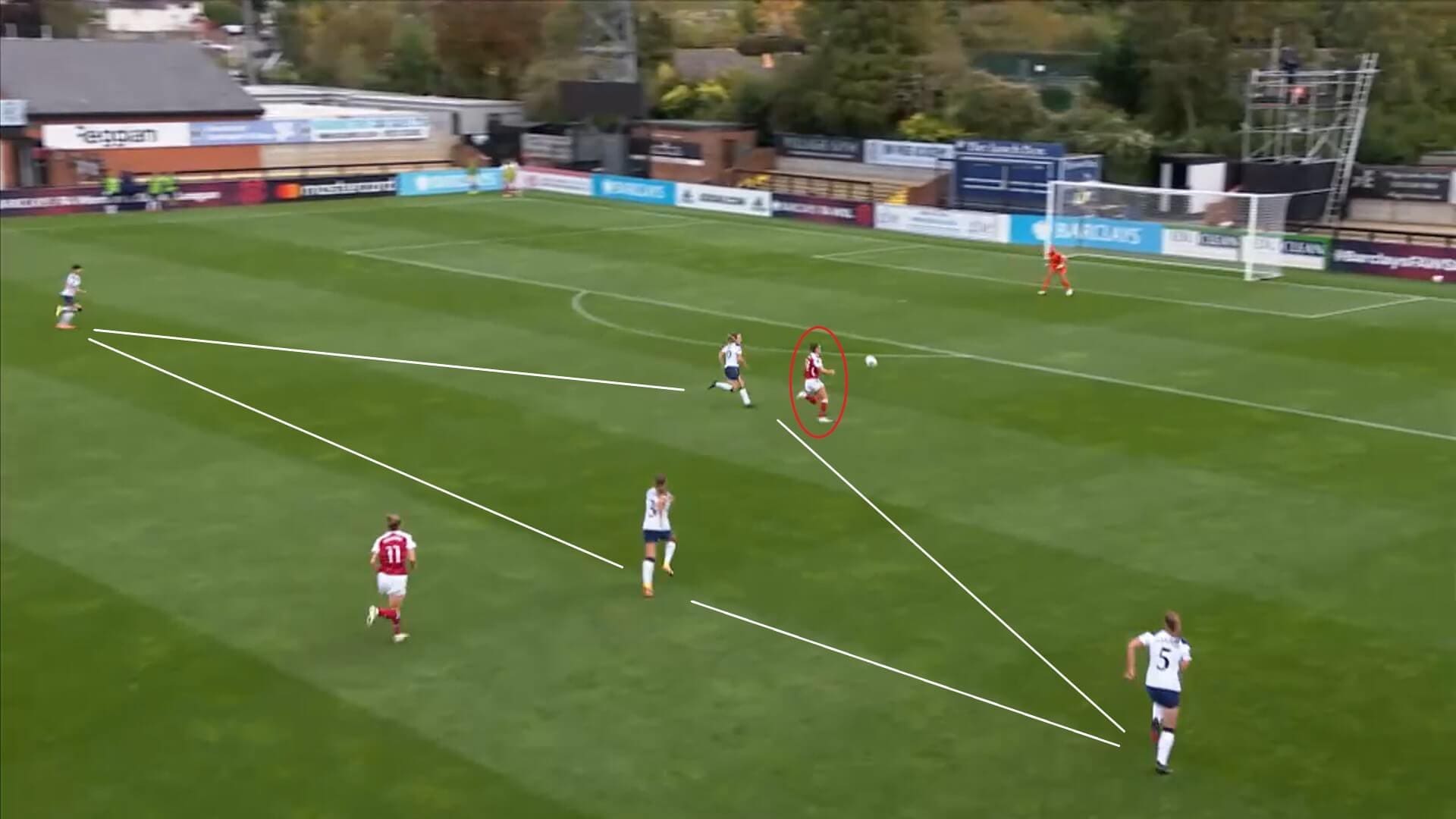
Arsenal’s third goal came from this situation, and, again, you can see how Tottenham’s defence was all over the place at the back. This situation shows how their back four structure has become something of a 1-3 formation. Therefore, it wasn’t very strong, and a long ball from centre-back Leah Williamson found Foord here, showing how Tottenham struggled to contain Arsenal’s attackers. Foord, in the red circle, runs through and scores easily here, further highlighting the obvious issues for Tottenham at the back.
One possible reason for Tottenham’s defensive shape being so poor here might be Vivianne Miedema’s (number 11) position. We know she likes to move around the pitch and not just stay as the centre forward, and here she has moved towards the halfway line, with Caitlin Foord taking up the central striking position in her place. However, given Miedema’s threat on the pitch, Tottenham’s defenders have looked to mark her. This then opens up the space behind the defence for Foord, as we can see here. This is clever from Arsenal, because they use Miedema to take defenders away from the box, creating space wherever they need to; Foord was the beneficiary of this here.
What these two images have shown is how Arsenal played with a good tempo and creativity, but Tottenham’s defence gave them so much space to work with that the first half was very one-sided. They have highlighted how there was a definite lack of communication and organisation at the back for Tottenham, which was costing them, as they were punished by Arsenal time and time again.
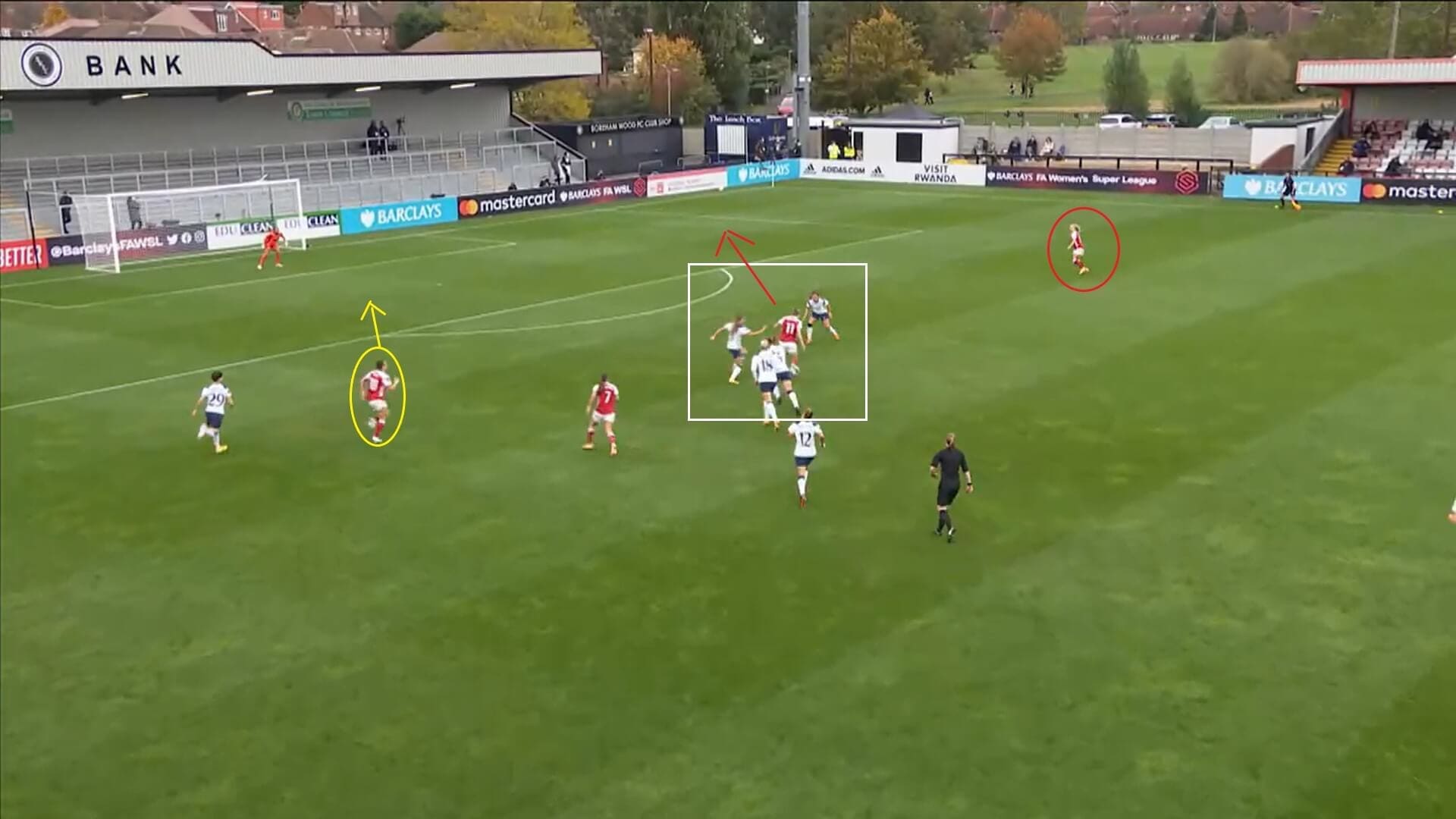
We can see here how this continued into the second half, although it was less constant. Miedema has again attracted the Tottenham defenders around her, as the white square shows, and this has left Beth Mead in acres of space on the far side of the pitch. Miedema slides the ball through to Mead, who then passes it back inside to Foord, who makes her run to meet it in the box and score. This is clearly something Tottenham need to work on ahead of their next game.
When you look at all of these examples, it’s not hard to see why Arsenal scored six goals against Tottenham. However, it should be noted that, in the second half, Tottenham seemed to have more shape, as we can see here.
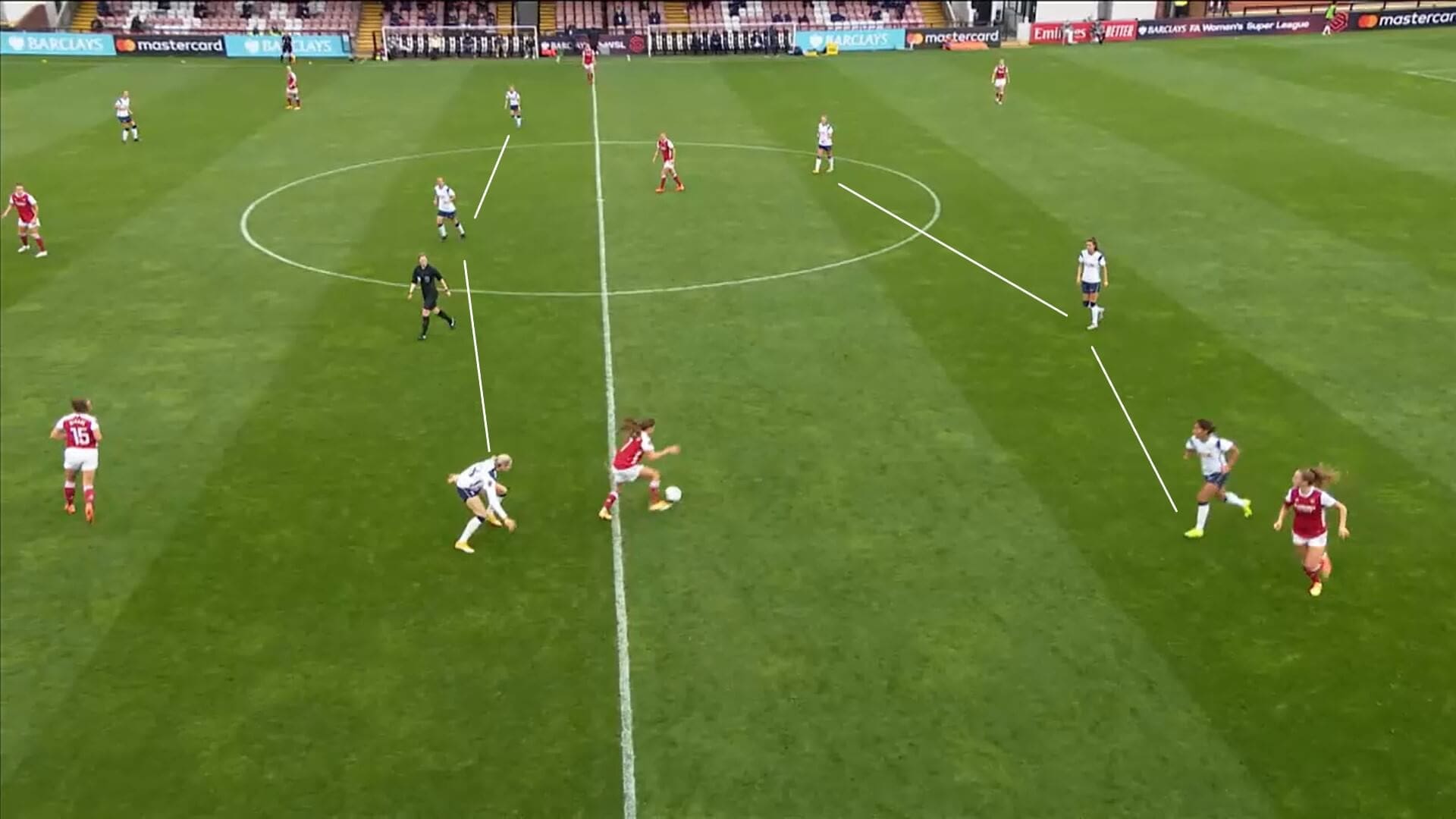
They started the game with one striker, Rianna Dean, but ended it with a front three, and a 4-3-3 formation, allowing them to cover more space on the pitch. This meant that Arsenal carried less of a threat in the second half, and were forced to move the ball around much more to find gaps. You can see from this image how Arsenal have been caught between the midfield and attack, and have to pass the ball backwards here. The centre-backs have also split, playing either side of the Tottenham attack. Therefore, Tottenham caused them more problems with this 4-3-3 structure, as Arsenal had to look for space rather than just being in it.
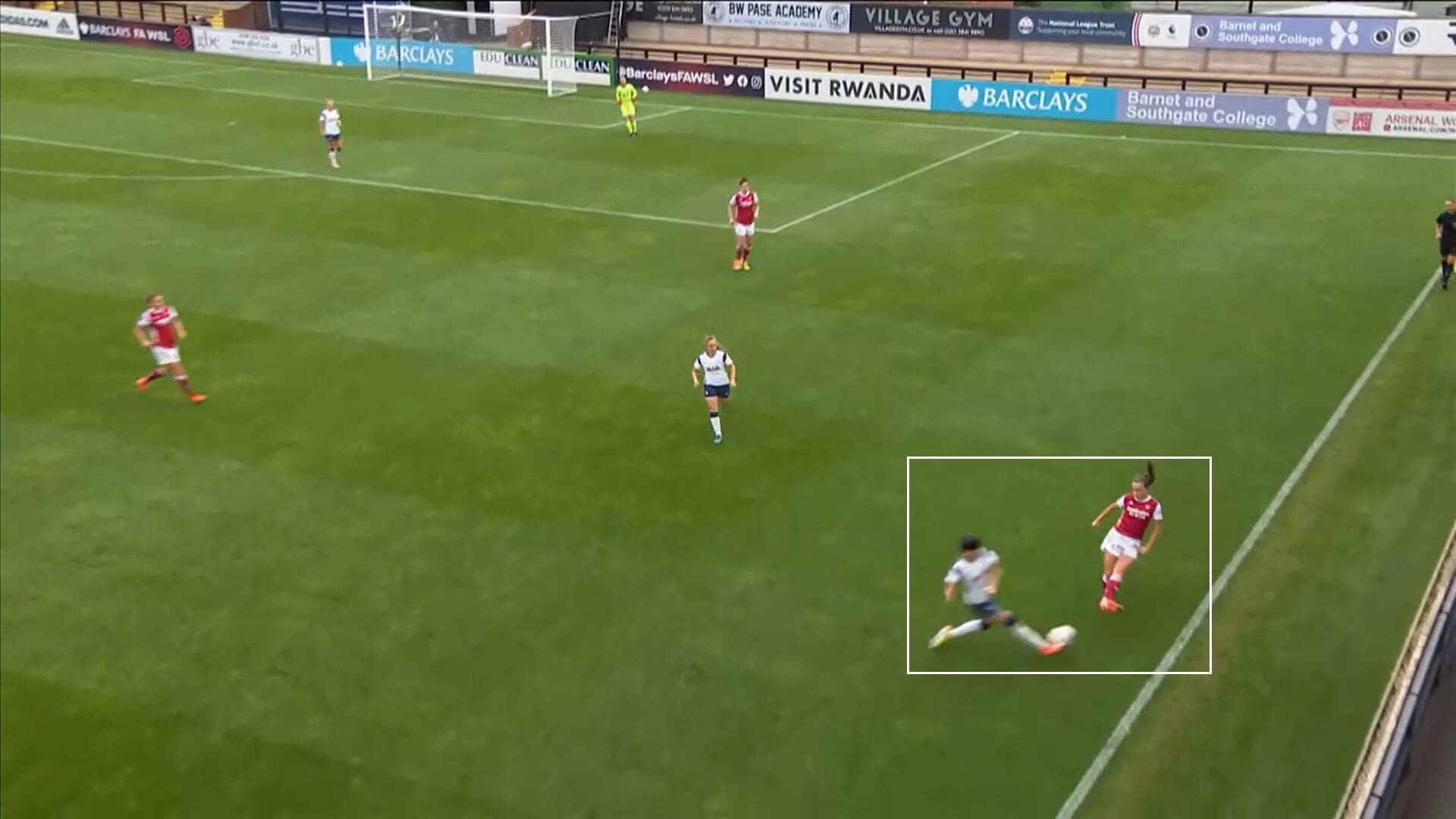
They also committed more to making tackles, pressing Arsenal in possession. Here, Ashleigh Neville has run up the pitch, blocking left-back Katie McCabe’s attempted pass. By pressing Arsenal in this way, Tottenham forced them to move the ball quicker, which generally leads to more errors. The game in the second half was much more closely contested as a result, with fewer opportunities being created and the ball being passed around much more by both sides.
Tottenham Hotspur Women’s attack
We have looked at Tottenham Hotspur Women’s errors in defence, allowing Arsenal to score some easy goals, and their changes in the second half to improve this. However, they were just as poor when attacking, because, when they got the ball into Arsenal’s third, they couldn’t make their opportunities count.
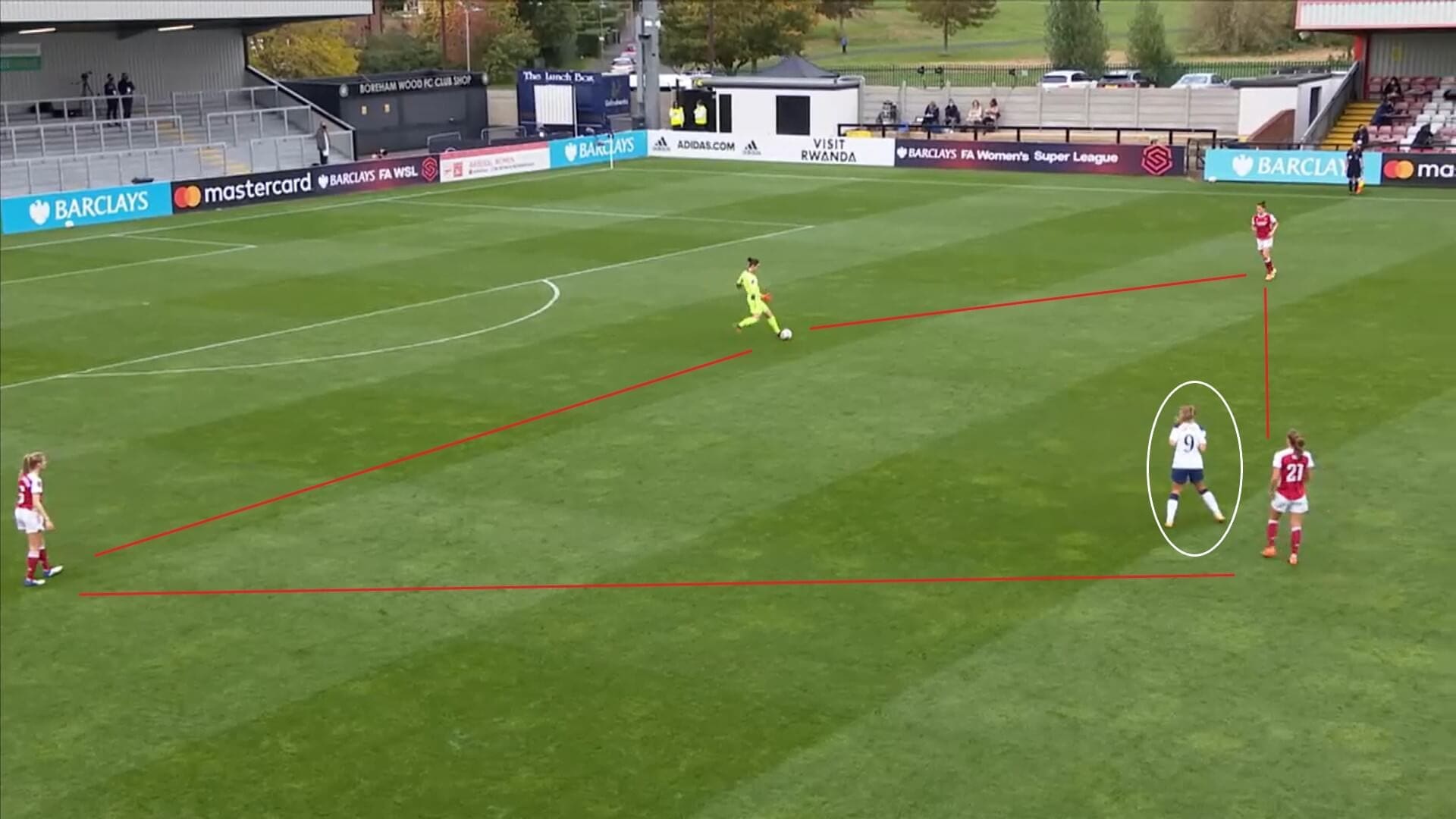
In this image, we can see the problem Tottenham have had over most of this season so far. They line up with one striker most of the time, but then that striker is left to play against a well-organised opposing defence. As we can see here, Arsenal just spread across the pitch, making it as big as possible, meaning Tottenham had no chance of winning the ball in these areas. This is the exact same problem that we saw Tottenham have against Everton Women two games ago, when Tottenham had one striker and Everton played around them. Therefore, it is clearly an issue in Tottenham’s attacking tactics, and one that they need to address.
It was noticeable that Tottenham’s joint-managers Juan Amoros and Karen Hills made changes only 40 minutes into the game, with Arsenal by then 3-0 up and the game as good as over. Lucy Quinn and Gemma Davison were withdrawn, with forwards Lucia Leon and Rosella Ayane brought on, as the away side changed to a front three, with Ayane down the middle, and Dean and Leon on either side of her. This gave them more of a threat, and Arsenal found it harder to pass the ball around them, but Tottenham still couldn’t make this new tactical setup count; winning a penalty and then seeing it saved and the rebound put over highlighted their lack of quality in the final third.
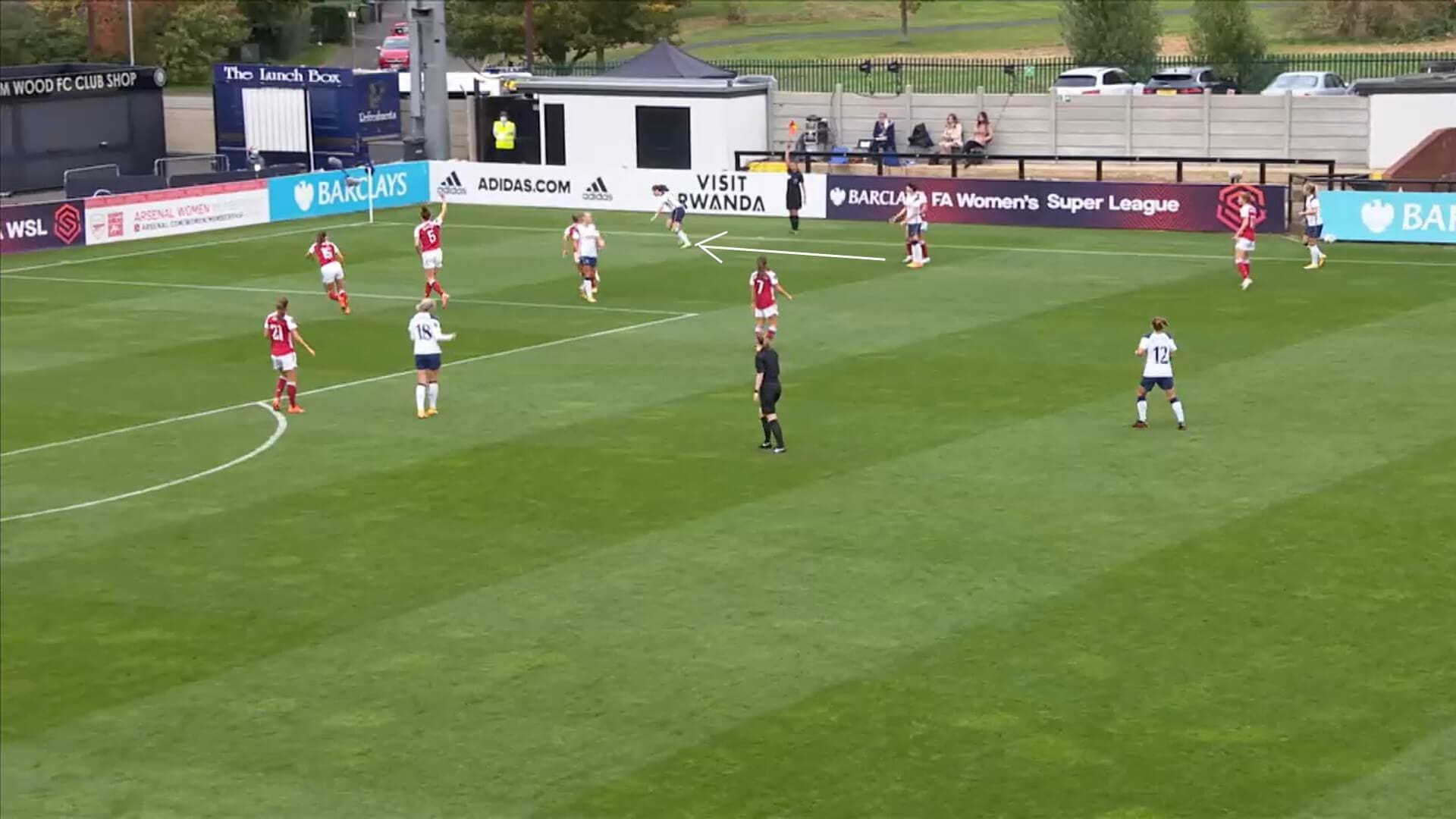
The other thing that Tottenham did was that, when they did get into good attacking positions, they made basic errors such as this, when the pass, indicated by the white arrow, was rushed, and the player receiving it was caught offside. This then gave the ball back to Arsenal in a very cheap way, whereas it could have given Tottenham a good opportunity to cross the ball into the box and ask questions of Arsenal’s defence. Therefore, we can see that this, as well as the issues with their setup, meant that the away side struggled to make an impact in the game. This is also shown by the fact that this section only contains two images.
Conclusion
In conclusion, it is clear that this North London derby will be one to remember for Arsenal Women, who made it five wins from five, and are now the only team with maximum points in the WSL. However, it will be one that Tottenham Hotspur Women will want to forget very quickly, except that there are lessons they will need to learn from their performance and the result. It will help them that there are now no league games for a couple of weeks, so they can work on the things that are continually hurting them. Arsenal will need to continue working, because they only have one clean sheet in their five games so far, against Brighton last weekend, but will still be happy with their continuous high standard of performances this season. After the break, Arsenal will travel to Manchester United Women, whilst Tottenham will host Reading Women.





Comments